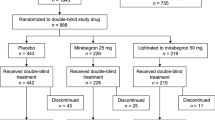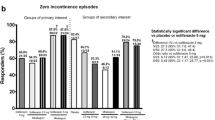Abstract
Purpose
To evaluate the efficacy and safety of solifenacin for the treatment of OAB in men.
Methods
This prospective observational study, reflective of actual practice patterns, was conducted in men older than 18 years who were prescribed solifenacin for the treatment of OAB symptoms. Men with suspected bladder outlet obstruction were excluded. The primary efficacy measure was change in OAB symptoms after 12 weeks of solifenacin. Also assessed were changes in severity of urinary urgency, IPSS, quality of life, cognitive function, and adverse events. Data were analyzed using descriptive methods.
Results
A total of 799 men recruited at 251 centers, average age 67 years (range 27–92), received solifenacin 5 mg or 10 mg/day. Mean episodes of urinary urgency, frequency, and nocturia decreased by 4.4, 3.6, and 1.4 episodes/24 h, respectively. As per IPSS, severe urinary symptoms were reported by 20.4 % at baseline versus by 2.3 % at week 12. Both voiding and storage symptoms showed improvement. Patient-reported general health condition was excellent/good for 39 % at baseline increasing to 76 % at week 12. Adverse event rate was 5.5 %, and discontinuation of solifenacin due to an event was 1.6 %. No change in post-void residual urine volume was experienced in 80%, while an increase of ≥50 mL was observed in 2.2 %; no cases of acute urinary retention occurred. Baseline mean MMSE was 27.5 points versus 27.9 points at week 12.
Conclusions
Solifenacin reduced all OAB symptoms, was well tolerated, and had no apparent effect on post-void residual urine volume. Cognitive function was unaltered in this population of older men with OAB.


Similar content being viewed by others
References
Abrams P, Cardozo L, Fall M et al (2002) The standardization of terminology of lower urinary tract function: report from the standardization sub-committee of the International Continence Society. Neurourol Urodyn 21:167–178
Rosen R, Altwein J, Boyle P et al (2003) Lower urinary tract symptoms and male sexual dysfunction: the multinational survey of the aging male (MSAM-7). Eur Urol 44:637–649
Irwin DE, Milson I, Hunskaar S et al (2006) Population-based survey of urinary incontinence, overactive bladder, and other lower urinary tract symptoms in five countries: results of the EPIC study. Eur Urol 50:1306–1315
Oelke M, Bachmann A, Descazeaud A et al (2013) EAU guidelines on the treatment and follow-up of non-neurogenic male lower urinary tract symptoms including benign prostatic obstruction. Eur Urol 64:118–140
Morant SV, Reilly K, Bloomfield GA, Chapple C (2008) Diagnosis and treatment of lower urinary tract symptoms suggestive of overactive bladder and bladder outlet obstruction among men in general practice in the UK. Int J Clin Pract 62:688–694
Oelke M, Burger M, Castro-Diaz D et al (2012) Diagnosis and medical treatment of lower urinary tract symptoms in adult men: applying specialist guidelines in clinical practice. BJU Int 110:710–718
Andersson KE, Chapple CR, Cardozo L et al (2009) Pharmacological treatment of overactive bladder: report from the International Consultation on Incontinence. Curr Opin Urol 19:380–394
Hefland BT, Evans RM, McVary KT (2010) A comparison of the frequencies of medical therapies for overactive bladder in men and women: analysis of more than 7.2 million aging patients. Eur Urol 57:586–591
Kaplan SA, Roehrborn CG, Dmochowski R, Rovner ES, Wang JT, Guan Z (2006) Tolterodine extended release improves overactive bladder symptoms in men with overactive bladder and nocturia. Urology 68:328–332
Roehrborn CG, Abrams P, Rovner ES, Kaplan SA, Herschorn S, Guan Z (2006) Efficacy and tolerability of tolterodine extended-release in men with overactive bladder and urgency urinary incontinence. BJU Int 97:1003–1006
Kaplan SA, Goldfischer ER, Steers WD, Gittelman M, Andoh M, Forero-Schwanhaeuser S (2010) Solifenacin treatment in men with overactive bladder: effects on symptoms and patient-reported outcomes. Aging Male 13:100–107
Temml C, Heidler S, Ponholzer A, Madersbacher S (2005) Prevalence of the overactive bladder syndrome by applying the International Continence Society definition. Eur Urol 2005:622–627
Milson I, Kaplan SA, Coyne KS, Sexton CC, Kopp ZS (2012) Effect of bothersome overactive bladder symptoms on health-related quality of life, anxiety, depression, and treatment seeking in the United States: results from EpiLUTS. Urology 80:90–96
Chapple CR, Rechberger T, Al-Shukri S et al (2004) Randomized, double-blind placebo- and tolterodine-controlled trial of the once-daily antimuscarinic agent solifenacin in patients with symptomatic overactive bladder. BJU Int 93:303–310
Cardozo L (2004) Randomized, double-blind placebo-controlled trial of once-daily antimuscarinic agent solifenacin succinate in patients with overactive bladder. J Urol 172:1919–1924
Kelleher CJ, Cardozo L, Chapple CR, Haab F, Ridder AM (2005) Improved quality of life in patients with overactive bladder symptoms treated with solifenacin. BJU Int 95:81–85
Fox C, Richardson K, Maidment ID et al (2011) Anticholinergic medication use and cognitive impairment in the older population: the medical research council cognitive function and ageing study. J Am Geriatr Soc 59:1477–1483
Whalley LJ, Sharma S, Fox HC et al (2012) Anticholinergic drugs in late life: adverse effects on cognition but not on progress to dementia. J Alzheimers Dis 1:253–261
Barry MJ, Fowler FJ Jr, O’Leary MP et al (1992) The American Urological Association symptom index for benign prostatic hyperplasia. The Measurement Committee of the American Urological Association. J Urol 148:1549–1557
Zinner N, Harnett M, Sabounjian L, Sandage B, Dmochowski R, Staskin D (2005) The overactive bladder-symptom composite score: a composite symptom score of toilet voids, urgency severity and urge urinary incontinence in patients with overactive bladder. J Urol 173:1639–1643
Kelleher CJ, Ld Cardozo, Khullar V et al (1997) A new questionnaire to assess the quality of life of urinary incontinent women. Br J Obst Gynaecol 104:1374–1379
Folstein MF, Fostein SE, McHugh PR (1975) “Mini-mental state”. A practical method for grading the cognitive state of patients for the clinician. J Psychiatr Res 12:189–198
Fitzpatrick JM, Desgrandchamps F, Adjali K, Gomez Guerra L, Hong SJ, El Khalid S, Ratana-Olarn K (2011) Management of acute urinary retention: a worldwide survey of 6074 men with benign prostatic hyperplasia. BJU Int 109:89–95
Negro CLA, Muir GH (2012) Chronic urinary retention in men: how we define it, and how does it affect treatment outcome. BJU Int 110:1590–1594
Kaplan SA, McCammon K, Fincher R, Fakhoury A, He W (2009) Safety and tolerability of solifenacin add-on therapy to α-blocker treated men with residual urgency and frequency. J Urol 182:2825–2830
Gromley EA, Lightner DJ, Burgio KL et al (2012) Diagnosis and treatment of overactive bladder (non-neurogenic) in adults: AUA/SUFU guideline. J Urol 188(6 Suppl):2455–2463
Theobald K, Capan M, Herbold M, Schinzel S, Hundt F (2009) Quality assurance in non-interventional studies. Ger Med Sci 7: Doc29. doi:10.3205/000088
Concato J, Shah N, Horwitz RI (2000) Randomized, controlled trials, observational studies, and the hierarchy of research designs. N Engl J Med 342:1887–1892
Acknowledgments
We thank the participating urologists for their help in data collection. Astellas GmbH, Germany, provided financial support for this study. Tanja Fielenbach and Michael Mader (Medidata, Germany) conducted the statistical analysis, funded by Astellas. Writing and editing assistance was provided by C. Krcmar, CRKrcmar Medical Communications, and was funded by Astellas. All authors have received consulting and lecture fees from Astellas. M. Vogel is an employee of Astellas GmbH. No remuneration was awarded to the authors for their participation in this study.
Author information
Authors and Affiliations
Corresponding author
Additional information
This study was registered at www.vfa.de/nis, number NIS Vesi 10 (MOVE).
Electronic supplementary material
Below is the link to the electronic supplementary material.
Rights and permissions
About this article
Cite this article
Burger, M., Betz, D., Hampel, C. et al. Efficacy and tolerability of solifenacin in men with overactive bladder: results of an observational study. World J Urol 32, 1041–1047 (2014). https://doi.org/10.1007/s00345-013-1179-z
Received:
Accepted:
Published:
Issue Date:
DOI: https://doi.org/10.1007/s00345-013-1179-z




